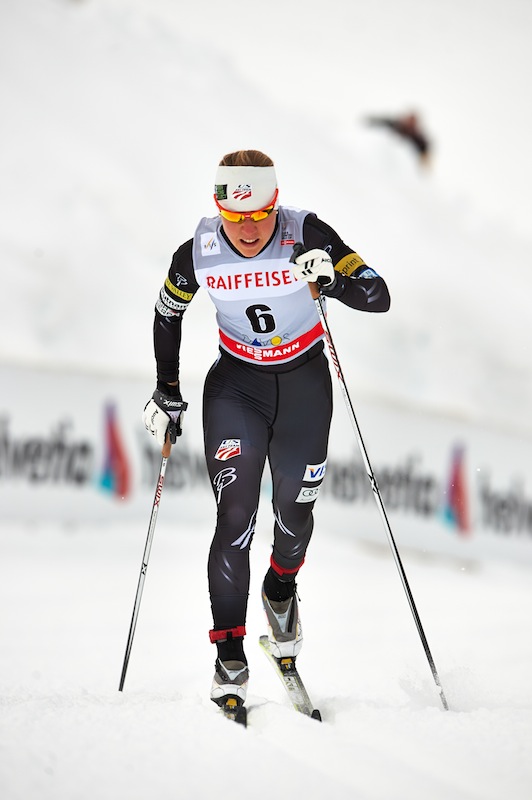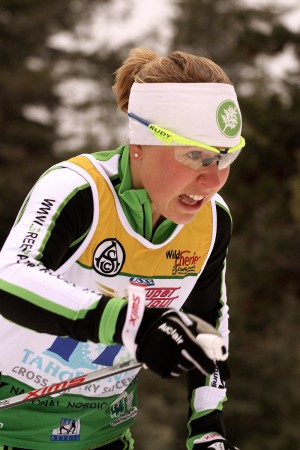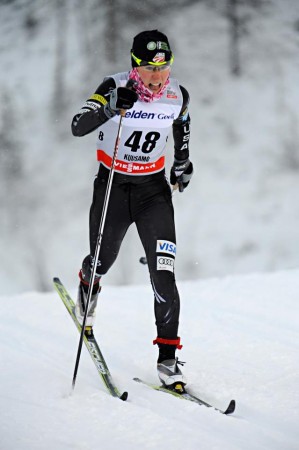
It was in the first sprint of the year in Kuusamo, Finland, last November that Ida Sargent cut her teeth on a World Cup semifinal. It was the start of the Ruka Triple, and in the quarterfinals she swung from sixth to second to comfortably move past the first round of heats. U.S. Ski Team women’s coach Matt Whitcomb remarked afterwards that it was “a career-breakthrough kind of day for Ida that we’ve known has been in the cards for a long time.”
A few months later, a career-breakthrough kind of day became part of a career-breakthrough kind of season when Sargent finally cracked the A-final in Sochi, Russia, in the unlikeliest of ways: in the skate technique, which she considers her weaker discipline.
By that point in the year, Sargent was a few months removed from her breakthrough in Kuusamo and had made it past the quarterfinals on one other occasion. Confidence had set in, and in Sochi the A-final had entered the realm of reasonable expectations for her.
“I thought it could be a good day but it’s a sprint, so you never know what’s going to happen,” Sargent said after the race. She finished sixth that day at the back of the heat and promptly became hungry for more.
“I think I made it to the final and was like, ‘Woah, what am I doing here? This is crazy, this is fun,’ but I wasn’t fully prepared when the gun went off,” Sargent said in a phone interview last week. “So I want to make more appearances in the finals [and] hopefully build another step towards a World Cup podium down the road.”

It’s June now, and Sargent is at home working to build on her confidence from last season. The first USST camp of the year has come and gone and she’s back in Craftsbury, Vt., at the training ground she is most comfortable in.
“This is the perfect place for me,” Sargent said. “I grew up near here, so I’m used to the rural lifestyle…and we spend so much time on the road in the winter that having the opportunity to be at home in one place feels great.”
Sargent now carries both confidence and focus into her new training season. When she looks back, she attributes experience as principally enabling her to reach a new competitive level. Her break into the top six came in just her second full season on the World Cup; in 2011/2012 her personal best was 29th.
“The year before I had some experience on the World Cup, figuring out how that works,” Sargent said. “Some of the venues I’d raced before, so that always helps. When you’re in a sprint qualifier and you only have three minutes, and the competition is so tight…if you make a little mistake you’re a few hundredths out. Getting to know the courses and feeling more comfortable on the road was a huge deal for me.”
The second factor she credits with her breakthrough is the U.S. team’s chemistry, which is frequently discussed by her teammates, too. The Americans are so visibly invested in each other’s success that a French national development coach traveled all the way to Bend, Ore., last month to take notes on their group dynamic.
“Another year as part of the team has really helped,” Sargent said. “One thing we do really well together is just training together at camps and on the road… I can ski skate threshold skate intervals with all the girls on the U.S. team, [and] so many of them have had a top-five finish in a distance skate race, or I can follow Kikkan in speeds. We all work really well together and feed off each other’s positive energy.”
This summer and fall, Sargent will train in a similar way that she has for years. At this point, she and her coaches know enough about what works well for her to not rock the boat before such an important season. This involved writing shorter altitude periods into her plan than some of her other U.S. teammates, but Sargent wants to stick with what she knows as she focuses on sprints this year.
“I grew up in Vermont at sea level and I haven’t ever put in a big role of altitude training into my plan, with the exception of camps here and there,” she said. “So this year, since it went well last year, there’s no reason to make big changes. Pepa [Miloucheva] and Matt [Whitcomb] both decided it’d be good to limit the amount of altitude training I did just to keep the speed and high intensity focus and continue the same things I’ve done in the past, rather than make a big change when things are already going well.”
Sargent made her summer training goals — to improve in strength, mobility and “especially” skate technique — with an eye towards the sprints in Sochi this February. They take place on the same course and close to the same time of year she made the A-final in the test events last season, and the events on the schedule are also identical: an individual freestyle sprint and a classic team sprint.
The U.S. team sprint candidates will be interesting to follow this year. Kikkan Randall and Jessie Diggins recently joined forces for World Championship gold in Val di Fiemme, Italy, but as they have since pointed out, classic sprinting is an entirely different game for each of them — skating is their stronger technique. Randall can still be top five in the world on a classic sprint day, but Diggins has not yet cracked the heats.
The day after her A-final breakthrough in Sochi last February, Sargent teamed up with Sadie Bjornsen in the classic team sprint for fifth place and finished less than four seconds off the podium. Sargent’s success in Sochi and familiarity with the sprint course could prove advantageous for her next year. She hopes so, anyway, but also acknowledges she has to make it onto the team first.

“It’s just a goal to be in Sochi,” she said. “That’s the first step; you can’t forget that. But it is important to kind of look past and pick out those races, and so it was really fun racing the team sprint last year and I’d love to be on that team again next year.”
On the way to the Games, Sargent wants to keep making the finals once the season begins again in Kuusamo.
“Making that final in Sochi last year was very exciting and kind of a huge breakthrough and not something I was expecting for last winter,” she said. “I think the goal is just to make the finals, keep moving through the heats, become more consistent at qualifying…The more experience you get head-to-head racing, the jump becomes easier as you become more comfortable skiing in the heats and learning the tactics and that type of racing mentality.”
With the Olympics still a long way off, Sargent is keeping a level head as she continues to invest the work into being named to that team.
“I think it’s impossible not to get excited about that; it’s the Olympics,” she said. “If you’re not excited and fired up thinking about it you probably shouldn’t be training for it. But at the same time there’s a lot of work to them and there’s a lot of training that needs to happen before then, so it’s important to stay smart and continue to do what I’ve done before. And feel confident that it will be the appropriate preparation for the upcoming winter.
“There’s a lot of time before then,” she continued. “[I’m] trying not to feel the pressure and continue to enjoy training and enjoy the camps and my time at home and just this lifestyle, because that’s the most important part.”
Audrey Mangan
Audrey Mangan (@audreymangan) is an Associate Editor at FasterSkier and lives in Colorado. She learned to love skiing at home in Western New York.



